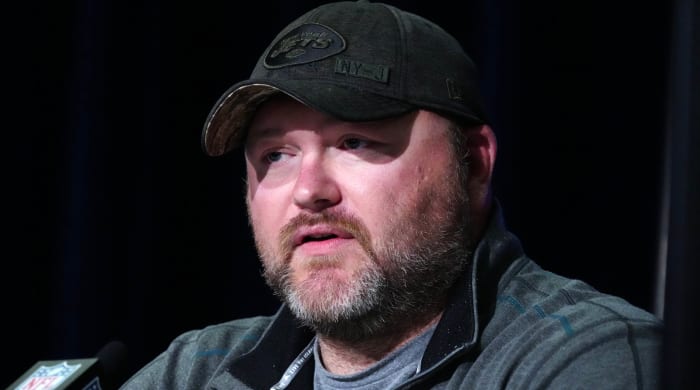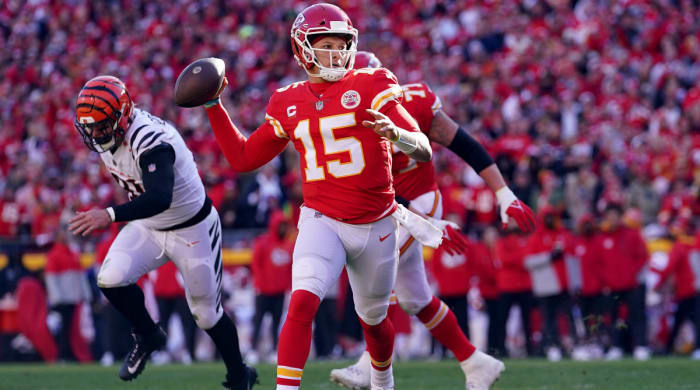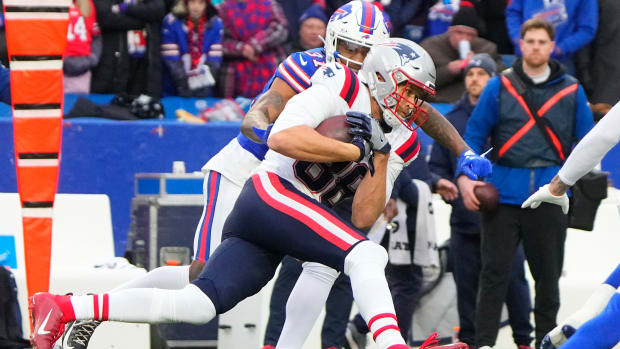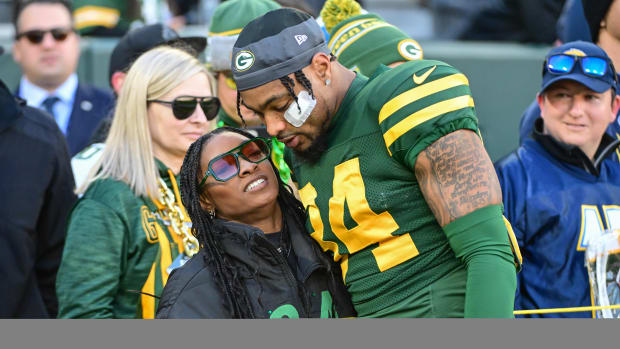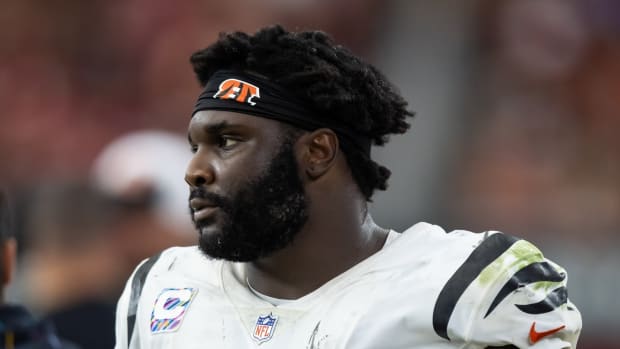Will More Players Leverage Their Way to Desired Trade Destinations?
Three weeks until the draft. And so this mailbag sets up as a little bit of a reset, with some big-picture questions looking back and more specific ones looking forward. Let’s dive in …
From Jack (@bullcitybills): It seems like there's a recent NBA style trend with reports that players (Tyreek Hill and Devante Parker being recent examples) are choosing their trade destinations. Are these one-offs or indicative of a larger shift in leverage?
Jack, this is a fascinating question, and you’re right. Hill is in Miami because he wanted to be there, just like Davante Adams is in Las Vegas, because that’s where he wanted to be. But it’s not just anyone who can pull that sort of thing off. And Hill and Adams have a few things in common that helped—both were on teams that had looming cap issues, with quarterbacks on massive (relatively) new contracts and were at the end of their own deals.
Because of that, and because both have already made their money, each carried leverage. Long story short, no team was going to give up the first-rounder-and-then-some ransom it’d take to get those guys without knowing they’d be around for a lot longer than a year—so Hill and Adams each had the leverage to refuse to negotiate with a team they didn’t want to go to.
Fortunately enough for everyone involved, it didn’t come to either guy having to tell other teams to get lost. The Packers knew from the start Adams wanted to reunite with his ex-college quarterback in Vegas, and the Chiefs gave Hill permission to seek a trade (and thus, figure it out on his own). That, in turn, led to relatively peaceful transactions over the last few weeks, in a spot where things definitely could’ve gotten more contentious.
So, sure, in these situations, where a team is motivated to move a guy, a guy’s contract is up and that guy is willing (and financially secure enough) to push the issue and good enough to be taken seriously, we certainly could see this happen again. Quarterbacks, of course, have found of late that they have the power to do it, as well—Russell Wilson, for example, absolutely dictated his landing spot.
The question then becomes where the line is drawn in just who can pull off what Hill and Adams just did. The group of players capable of it, as I see it, is still pretty small. But it’s also a whole lot bigger than it used to be.
From Max (@MaxLovesRunning): Albert- how much leverage is lost by the existing free agents after the draft? FAs like Mathieu, OBJ, Landry, etc. are still unsigned. Isn't it in their best interest to sign before the draft? Thanks!
Max, I don’t think much leverage is lost at all. If guys like Tyrann Mathieu, Odell Beckham Jr. and Jarvis Landry (and you can throw other third-contract guys like Jadeveon Clowney, Stephon Gilmore, Calais Campbell and Melvin Ingram into the fray) were must-haves for some team, they’d be signed by now. Their availability at this stage of the game means teams aren’t falling over themselves to sign them.
And that puts each in a position where waiting could help, for two specific reasons …
1. Come May 2, signings don’t count against teams in the compensation pick formula. And that often draws comp-pick-conscious teams like the Patriots, Ravens and Rams out and into the veteran market.
2. Once the draft has come and gone, the needs a team has become more clearly defined. No one wants to press needs on draft weekend (personnel people will tell you that free agency should be needs-based, the draft should be value-based), so going into and coming out of the draft with a specific need happens, and it can accelerate the market for experienced guys capable of filling such needs.
In other words, give it a little time with those guys. Some already have the wink-and-nod from teams waiting for that May checkpoint to pass. Others will probably see suitors materialize after the draft, for both of the reasons above. And as Clowney specifically has shown us the last couple of years, if you’re good enough, the jobs won’t suddenly evaporate because you decide to take your time in finding a destination.
From Haze (@RileyHaze3): Do you think the Jets use picks 4 and 10 in the first round or will they trade one for a proven NFL WR? Seems likely that pick 10 (and maybe something else) is being shopped aggressively.
I think the Jets would love to move down or move one of their picks to next year. As it stands, GM Joe Douglas holds the fourth, 10th, 35th, 38th, 69th, 111th, 117th, 146th and 163rd picks, a war chest built through the trades of Jamal Adams, Sam Darnold, Chris Herndon and Avery Williamson. That’s nine picks in the first five rounds, which could easily be turned into a dozen picks this year or set the team up for next year.
Now, here’s what’s tricky about it—while next year’s draft looks like it’ll be stronger at the top, dealing away the fourth or 10th picks would probably mean trading with someone picking lower than you, which naturally would mean that team is pretty good, and increase the chance next year’s pick is lower than the one you’re dealing away. At any rate, it’d be tough to bank on a pick landing in the top 10 a year out. Douglas would have to weigh that.
In the end, my guess is that the team’s need for a pass rusher, the desire for a tackle and the previous pursuit of a high-end receiver (Hill) matches up nicely with the players who figure to be best available when the Jets are picking. And given where they are in the their building process, wanting to maximize Zach Wilson’s rookie contract window, I can see where it might make sense just to take the best guy now.
But if maybe someone’s will to deal what they’d expect to be a late first in 2023 for the 35th pick? That’s a fun idea.
From Paul Andrew Esden Jr (@BoyGreen25): The Jets seem aggressive as heck to land a WR1 this offseason via trade, do you think they'll be able to do it? If so who is it and for what price?
I think, and applaud the effort, they’re doing all they can to get answers on Zach Wilson in Year 2. They have rising star Elijah Moore, signed Corey Davis last year, and C.J. Uzomah and Tyler Conklin in March, and brought back Braxton Berrios, too. They keep bolstering the line, and it’s a good bet one of those two areas (the skill positions and line), if not both, will get another boost early in the draft.
So yeah, I think for the next three weeks, Douglas is gonna stay loose with those four picks, and open to the idea of adding another receiver. Whether it happens sort of depends on who becomes available between now and then.
From CB (@IslandBoy3188): Which one do you like better: C.J. Stroud or Bryce Young? Try not to be biased either lol
CB, I’ll say this—I’d be concerned about Young’s size. And here’s an illustration of it …
Left to right, that’s Aidan Hutchinson, Kenny Pickett, C.J. Stroud and Young at last year’s Heisman ceremony. Pickett and Stroud are relatively average sized as quarterbacks go, and both look a whole lot bigger than Young does. And while everyone points to the success of Russell Wilson, where are the examples of smaller, shorter quarterbacks since? Kyler Murray, maybe, but he’s a freak athlete. And Wilson runs a 4.5.
Is Young that kind of athlete? I don’t know. If he’s not, history tells us it’ll be hard for him to make it as an NFL quarterback (Tua Tagovailoa, Baker Mayfield and Johnny Manziel were all shorter, and good but not great athletes)—remember, it took Drew Brees a lot of time to hit his stride as an NFL player, and that was in a different time.
I haven’t really asked around enough on Stroud and Young, at this point, to have a great handle on where the NFL stands on them. But in the end, I’d bet a lot of teams would look at the tape of the two as comparable. And my guess is if that’s the case, Stroud would go first, based on his size and ability to operate efficiently within the confines of the pocket.
From Devon Zook (@devon_zook): What is the most out-of-the-box but possible pick for Jags at No. 1?
Devon, that’s the weird thing about this year, I don’t know what you’d consider outside the box. Everyone’s seen Hutchinson in that spot, as well as N.C. State’s Ikem Ekwonu and Alabama’s Evan Neal, with Georgia DE Travon Walker emerging as a dark horse. And getting an edge rusher to play opposite Josh Allen would make some sense, as would continuing to build up the offensive line (if you look at how Doug Pederson’s best teams won in Philly).
So if it’s not an offensive or defensive lineman?
The one name that comes to mind is Cincinnati CB Sauce Gardner. I know evaluators who believe he’s the best player in the class. Corners never go that high. But in a year that’s shaky at the top, might it be worth a swing to address a big need? It’s at least worth a thought.
From Amy (@Amy11074): Are the Titans seriously considering drafting a QB in the first round?
Amy, I think they’ll investigate it. For right now, they’re in on Ryan Tannehill for one more season at $29 million cash (his cap hit is $38.6 million). In 2023, the final year of the four-year deal he signed in early ’22, he’s due a nonguaranteed $27 million, and the team could cut him if it’s willing to absorb an $18.8 million dead-cap hit. At any rate, the discussion on where the Titans will be at QB in ’24 has to be starting soon internally.
To me, that means looking into the top five guys in this year’s class—Liberty’s Malik Willis, Pitt’s Kenny Pickett, Ole Miss’s Matt Corral, Cincinnati’s Desmond Ridder and North Carolina’s Sam Howell—so you at least know what you’re passing on with the 26th pick, if you do the more conventional thing and fill a more immediate need on a win-now roster.
All of that said, I’m at least keeping my eye on Ridder. His coach, Luke Fickell, has gushed to NFL teams about him. And Fickell happens to be best friends with Titans coach Mike Vrabel. Would they spend the 26th pick on him? I don’t know. But I’m pretty sure that’s what it’d take. My guess is that Ridder would be gone by the time Tennessee picks again, at 90 (the Titans’ second-rounder went to Atlanta in the Julio Jones trade).
Could it be another one of the quarterbacks? Maybe. It doesn’t seem like the likeliest outcome here, but the team’s future at the position is more of a question now than it was a year ago.
From Han (@HanSolo25563981): How much of an impact will the Chiefs face losing so many WRs this offseason?
Han, I think much of it is going to come down to Patrick Mahomes’s growth, something we covered with Mahomes in last week’s GamePlan column. The Chiefs faced a litany of two-high looks last year, with defenses playing back to combat what Mahomes and Hill had done to teams for the three years previous, and it led to a shift in the way Kansas City played and a lot of growth from Mahomes himself.
That should help set the stage for post-Tyreek life for the Chiefs—that they had to go on more drawn-out, deliberate drives that required more precision and patience is a big plus, considering how subtracting Hill from the equation figures to affect the way defenses deal with Kansas City. And having bigger receivers like Marquez Valdes-Scantling and JuJu Smith-Schuster should help in that regard too, with M.V.S. and Mecole Hardman also capable of creating a threat downfield to get the most out of Mahomes’s ability to hit shots.
Which, ultimately, is the great thing about this. When I asked Mahomes last week how not having Hill will change the way he and his offense are defended, he said, “I'm very interested [to see], honestly, because obviously we got a lot more to two-high shell zone coverages this last year and for a while it had a lot of success against us.” And conversely, with Hill, Byron Pringle and DeMarcus Robinson gone, it’ll be just as interesting to see how different the Chiefs look in 2022.
From Tampa Tom (@PatriotTrollG): What were the Saints thinking in making that trade?
Tom, I think it’s GM Mickey Loomis building for the here and now. Look at his roster, and you’ll see a core that’s got a couple more swings left in it—made up of guys like Cam Jordan (33), Alvin Kamara (26), Ryan Ramczyk (27), Michael Thomas (29), Marshon Lattimore (25), Demario Davis (33) and David Onyemata (29). And so a trade like this, selling off future assets at a premium for the here and now, portends one of two things.
1. The Saints love someone, maybe a quarterback, in the top 10, and want the ammo to get aggressive and go and get him. One reason why that doesn’t necessarily wash? With the number of teams in the top 10 looking to deal picks into 2023, the future assets might’ve been even more valuable than having a bunch now, which makes using the middle man (Philadelphia, in this case) appear to be unnecessary. Unless, of course, the Saints already have a trade partner who wants ’22 picks lined up.
2. With the long-standing cap issue lingering, and the 2017 class (Lattimore, Ramczyk, Kamara) now on high-end veteran contracts, the Saints really could use getting some front-line guys on rookie contracts. So having three picks within the top 50, especially when you look at the team’s record in the draft since ’16, gives them a really good shot to get that accomplished, and maybe the flexibility a year from now to walk away from an expensive, older guy or two.
So we’ll see what happens. From a value standpoint, I’d agree that it looks like the Eagles won the trade in a walk. But of the two teams involved, the one that’s actually shown the greatest ability to turn picks into productive players of late has been the Saints. Which means there is plenty of reason here to trust Loomis and scouting chief Jeff Ireland, even if the deal itself doesn’t look great when you line things up on the draft value chart.
From Brian Pelo (@Brian_Pelo): Given the current coaching staff on the Pats, what differences and similarities do you see offensively moving forward as compared to when Josh McDaniels was running the offense?
Brian, I think this is a good opportunity to tailor the offense to what Mac Jones does well, and the Patriots’ staff’s connections at Alabama—it’s not just Bill Belichick; Joe Judge worked there and Matt Patricia has developed a strong rapport with Nick Saban, too—should help in doing that effectively.
So what did Jones have at Bama? The ability to play point guard and set guys up to generate explosive plays after the catch (which played into Jaylen Waddle’s game, and now plays into Kendrick Bourne’s game), and also the out of being able to throw the ball up knowing he had guys who could get it (DeVonta Smith at Bama, and presumable DeVante Parker now). Which is to say where Jones still lacks a true No. 1, he has guys around him who play to his strengths, and that’s before you get to his security blanket, Hunter Henry.
And all that puts the onus on Judge, Patricia and Nick Caley to figure it out. The first two guys have little experience on offense, while the third has never been a coordinator before. Setting it up this way is, to be sure, a gamble by Belichick. We’ll see if those three can make it one that pays off.
From Jerrad Wyche (@JerradWyche): The Chicago Bears have a new GM adamant about building through the draft. How likely is it he moves up into the 1st to get a weapon for Justin Fields? And if he were to trade down in the 2nd, what would be the return in terms of compensation?
Jerrad! This is Ryan Poles’s and Matt Eberflus’s clear-the-decks season. The truth is that a proud Bears defense was starting to age out last year, but with everyone fighting for their jobs, it didn’t make sense to conduct a teardown then. It’s coming now, all of it (offloading vets, carrying dead-cap charges) with an eye on 2023, when the team will have a full complement of draft picks and, in all likelihood, over $100 million in room under the cap.
And yes, it sucks that the Bears have to do this in Fields’s second season, when he’ll be asked to adjust to a new staff and system. But it’s not wholly unlike how the Bills took their dead-cap medicine when Josh Allen was a rookie in 2018 (and weren’t able to stack the deck around him as a result). That one, as you might’ve seen, turned out all right.
So for now, you hope for development from Darnell Mooney and Cole Kmet, maybe a surprise uptick from a free-agent add like Pringle and perhaps the right receiver to fall to you in the second round, as you get Fields’s feet wet in Luke Getsy’s offense. And coming out of that, the idea would be to have an ascending Fields going into 2023, with plenty of capital, both cap- and draft-pick-wise, to supercharge what’s around the quarterback.
More NFL Coverage:

































